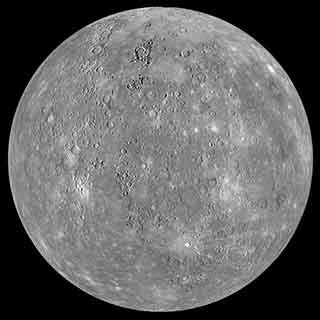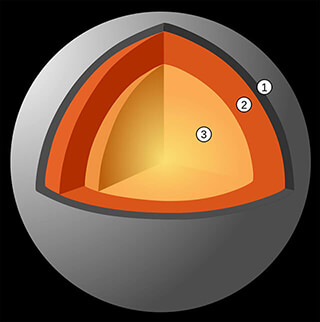Mercury
Mercury is a small rocky planet, the innermost planet of our Solar System.

Facts About Mercury:
- Mercury is the smallest planet in the Solar System and the closest to the Sun.
- Being closest to the Sun, Mercury orbits the Sun in the shortest amount of time and thus has the shortest year (87.97 Earth days).
- Despite being the closest planet to our Sun, it is not the hottest (that's the second planet, Venus).
- Mercury experiences the greatest temperature variation in the Solar System. Because it's so close to the Sun, Mercury gets very hot during the day (427°C). However, because it has no atmosphere to hold heat, it gets very cold at night (−173°C).
- Even the daytime side of Mercury is slightly less hot than Venus. This is because Venus is much better at holding its heat.
- The surface of Mercury is covered with craters and looks a lot like Earth's Moon. This indicates that there has been no geological activity for billions of years.
- Surface cracks were created when the planet cooled.
- Mercury has the most elliptical orbit of the planets.
- There are two moons in our Solar System that are larger than Mercury: Ganymede (orbiting Jupiter) and Titan (orbiting Saturn).
- Mercury has practically no axial tilt (its poles point straight up and down relative to its orbit).
- Mercury is the only planet in the Solar System to have no real atmosphere.
- It has a weak magnetic field.
- It has a higher iron content than any other planet in the Solar System.
- It is very dense, giving it the same surface gravity as the larger planet Mars.
- From our point of view on Earth, Mercury never gets very far away from the Sun (no more than 28°). This means that Mercury can only be seen near the horizon during the early evening or early morning.
- Mercury is relatively difficult to study. It's too close to the Sun for comfortable viewing from Earth, and the physics of spaceflight make it one of the more difficult planets to visit.
- The last space probe to visit Mercury was MESSENGER (2011 - 2015).
Classification: Planet (orbiting Sun)
Names: Sol I, Apārangi
Diameter: 4879.38 kmMass: 3.3 kg
Rotation period: 58.646 Earth days
Axial Tilt: 2.1100 °
Orbital Period: 87.9691
Orbital Speed: 47.3620 km/s
Eccentricity: 0.20563000
Density: 5.4270 g/cm3
Surface Area: 7.48 km2
Surface Gravity: 0.3800 g
Escape Velocity: 4.2500 km/s
Adjective: Mercurian, Mercurial

(1) Crust - 100-200 km thick
(2) Mantle - 600 km thick
(3) Nucleus - 1,800 km radius
(2) Mantle - 600 km thick
(3) Nucleus - 1,800 km radius
Credit: Joel Holdsworth
